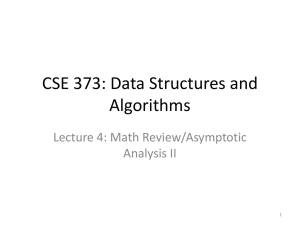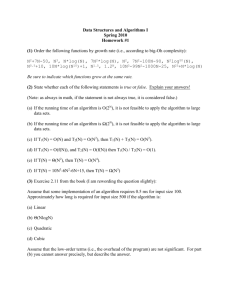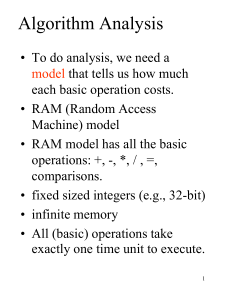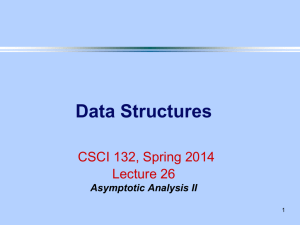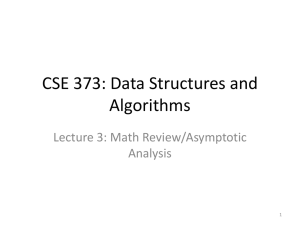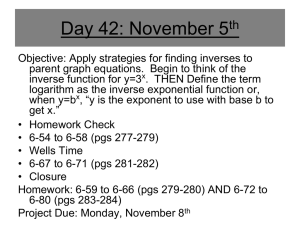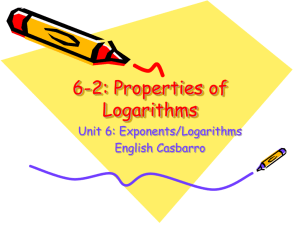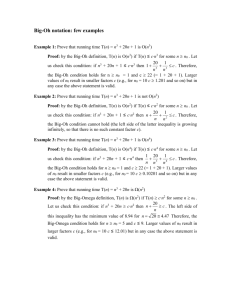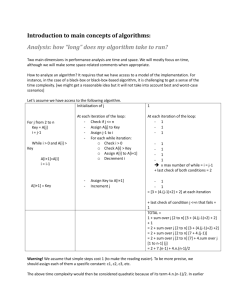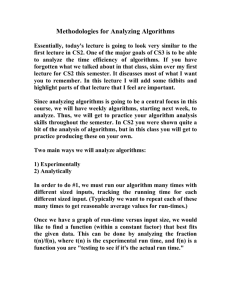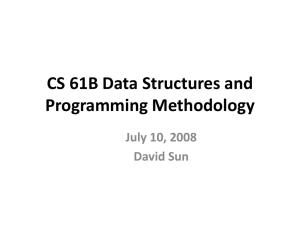Document
advertisement
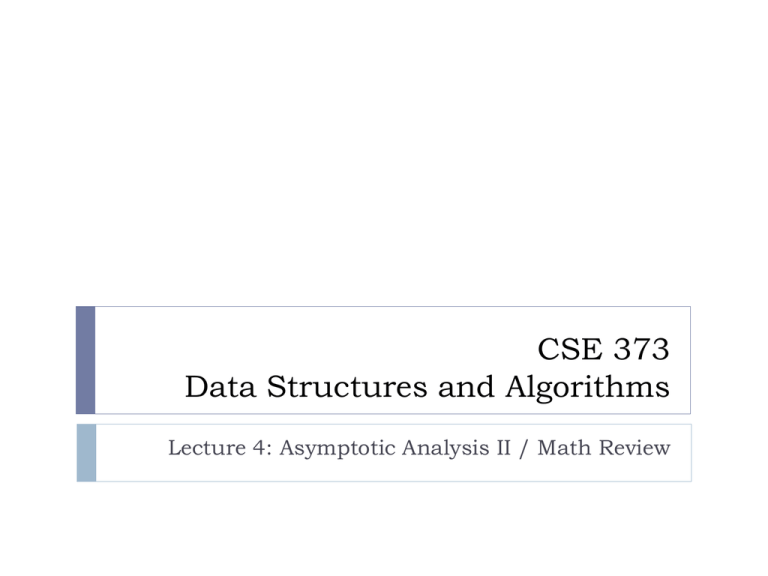
CSE 373
Data Structures and Algorithms
Lecture 4: Asymptotic Analysis II / Math Review
Big-Oh notation
Defn: f(n) = O(g(n)), if there exists
positive constants c and n0 such
that: f(n) c· g(n) for all n n0
Asymptotic upper bound
Idea: We are concerned with how
the function grows when N is
large.
We are not concerned with constant
factors
Lingo: "f(n) grows no faster than
g(n)."
2
c*
Functions in Algorithm Analysis
f(n) : {0, 1, } +
domain of f is the nonnegative integers (count of data)
range of f is the nonnegative reals (time)
We use many functions with other domains and ranges.
3
Example: f(n) = 5 n log2 (n/3)
Although the domain of f is nonnegative integers, the domain of
log2 is all positive reals.
Big-Oh example problems
n = O(2n) ?
2n = O(n) ?
n = O(n2) ?
n2 = O(n) ?
n = O(1) ?
100 = O(n) ?
214n + 34 = O(2n2 + 8n) ?
4
Preferred Big-Oh usage
Pick tightest bound. If f(n) = 5n, then:
f(n) = O(n5)
f(n) = O(n3)
f(n) = O(n log n)
f(n) = O(n)
preferred
Ignore constant factors and low order terms
f(n) = O(n), not f(n) = O(5n)
f(n) = O(n3), not f(n) = O(n3 + n2 + n log n)
Wrong: f(n) O(g(n))
Wrong: f(n) O(g(n))
5
Show f(n) = O(n)
Claim: 2n + 6 = O(n)
Proof: Must find c, n0 such that for all n > n0, 2n + 6 <= c * n
6
Big omega, theta
big-Oh Defn: f(n) = O(g(n)) if there exist positive
constants c and n0 such that f(n) c· g(n) for all n n0
big-Omega Defn: f(n) = (g(n)) if there exist positive
constants c and n0 such that f(n) c· g(n) for all n n0
Lingo: "f(n) grows no slower than g(n)."
big-Theta Defn: f(n) = (g(n)) if and only if f(n) =
O(g(n)) and f(n) = (g(n)).
7
Big-Oh, Omega, and Theta establish a relative ordering among
all functions of n
Intuition about the notations
notation
8
intuition
O (Big-Oh)
f(n) g(n)
(Big-Omega)
f(n) g(n)
(Theta)
f(n) = g(n)
Little Oh
little-Oh Defn: f(n) = o(g(n)) if for all positive constants c
there exists an n0 such that f(n) < c· g(n) for all n n0. In
other words, f(n) = O(g(n)) and f(n) ≠ (g(n))
9
Efficiency examples 3
sum = 0;
for (int i = 1; i <= N * N; i++) {
for (int j = 1; j <= N * N * N; j++) {
sum++;
}
}
What is the Big-Oh?
10
N3
N2
N5 + 1
Math background: Exponents
Exponents
XY , or "X to the Yth power";
X multiplied by itself Y times
Some useful identities
11
XA XB = XA+B
XA / XB = XA-B
(XA)B = XAB
XN+XN = 2XN
2N+2N = 2N+1
Efficiency examples 4
sum = 0;
for (int i = 1; i <= N; i += c) {
sum++;
}
What is the Big-Oh?
12
N/c
N/c + 1
Efficiency examples 5
sum = 0;
for (int i = 1; i <= N; i *= c) {
sum++;
}
What is the Big-Oh?
Equivalently (running time-wise):
i = N;
while (i > 1) {
i /= c;
}
13
logc N
logc N + 1
logc N
logc N + 1
Math background: Logarithms
Logarithms
definition: XA = B if and only if logX B = A
intuition: logX B means: "the power X must be raised to,
to get B”
In this course, a logarithm with no base implies base 2.
log B means log2 B
Examples
14
log2 16 = 4
(because 24 = 16)
log10 1000 = 3 (because 103 = 1000)
Logarithm identities
Identities for logs:
log (AB) = log A + log B
log (A/B) = log A – log B
log (AB) = B log A
Identity for converting bases of a logarithm:
log
B
C
log
B
A
,
B
,
C
0
,
A
1
A
log
A
C
15
example:
log4 32 = (log2 32) / (log2 4)
=5/2
Techniques: Logarithm problem solving
When presented with an expression of the form:
logaX = Y
and trying to solve for X, raise both sides to the a power.
X = aY
When presented with an expression of the form:
logaX = logbY
and trying to solve for X, find a common base between
the logarithms using the identity on the last slide.
logaX = logaY / logab
16
Prove identity for converting bases
Prove logab = logcb / logca.
17
A log is a log…
We will assume all logs are to base 2
Fine for Big Oh analysis because the log to one base is
equivalent to the log of another base within a constant
factor
18
E.g., log10x is equivalent to log2x within what constant factor?
Efficiency examples 6
int sum = 0;
for (int i = 1; i <= n; i++) {
for (int j = 1; j <= i / 2; j += 2) {
sum++;
}
}
19
Math background: Arithmetic series
Series
k
Expr
i j
for some expression Expr (possibly containing i), means the sum
of all values of Expr with each value of i between j and k inclusive
Example:
4
2i 1
i0
= (2(0) + 1) + (2(1) + 1) + (2(2) + 1) + (2(3) + 1) + (2(4) + 1)
=1+3+5+7+9
= 25
20
Series Identities
Sum from 1 through N inclusive
N
N
(N
1
)
i
2
i
1
Is there an intuition for this identity?
Sum of all numbers from 1 to N
1 + 2 + 3 + ... + (N-2) + (N-1) + N
21
How many terms are in this sum? Can we rearrange them?
